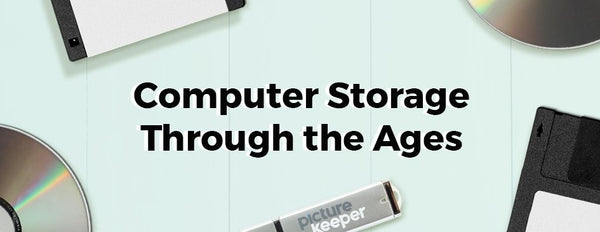Computer Storage Through the Ages
Apr 09, 2018
Things have changed quite a bit since the time of dial-up internet. At computers earliest stages, they were not compact enough to fit into homes and backing up information was done with a punch card system, magnetic tapes, or hard drives that were much too large for a house. Thankfully, technology has come a long way! Let’s take a look back at the journey that got us to where we are today.
Floppy Disks: 1969

Hard drives were the first method to store information from computers. They were large (at first) and far too expensive for an everyday person to use in their homes. Floppy disks were the first backup mechanism that were small and cheap enough to use for home computers.
If you remember these little guys, the first ones contained an 8-inch disk that held all your important computer files. You would insert the disk into the computer, save your files onto the disk, and then store the disk somewhere safe. Their flexible plastic casing created their nickname “floppy,” and they only held between 360 kilobytes – 1.44 megabytes of storage. That’s less than 1GB!!
There were a few inconveniences with the early floppy disk styles. With their limited storage capacity, difficulty to store, and ability to become easily contaminated, they were soon beat out by other technology enhancements.
Compact Disks: 1980s

The Compact Disk, or CD, was created in 1982 by Sony. It was originally only meant to store and play sound recordings only, but was later adapted to store other types of data. While hard drives could hold more data, CDs were still the cost-efficient option and why they became so popular among households. With the invention of the DVD that held around 4GB of data in the 1990s, these were must-haves to store their important files.
Again, technology advanced and eventually CDs were no longer the convenient way to store files. While they are still used, their size and ability to be easily scratched if not stored properly has been their downfall.
Flash Drives: 1998

Flash Drives or the USB hit the market in late 1990s. Their small size and ability to hold large quantities of data made them instantly popular. The were also incredibly cost-efficient, making it easy for everyone to afford. From parents to professionals to students, flash drives became the universal way to save files.
Almost every desktop, laptop, and tv have a place to input a USB and are still used as a primary backup method.
Picture Keeper: NOW

Flash forward to 2018 and a lot of things have changed! Floppy disks are no longer and CDs sit on shelves thinking we’ll one day use them again. Now more than ever, it is essential we backup our most precious files, photos, and videos. They are much more than something we keep on our computer for professional use, but they contain memories we cherish from our smartphones, tablets, laptops, desktops and more.
Thankfully, we have the easiest solution for you and are the top way to backup your most precious memories in 2018. Picture Keeper offers a variety of products for whatever you need. Our Picture Keeper for Desktop is the perfect way to store all your photos from your computer, Picture Keeper Pro stores all your files and has our largest 500GB option, and Picture Keeper Connect is our most popular product backing up photos, videos, and contacts directly from smartphones and tablets.
Picture Keeper goes beyond your average USB, because it does all the hard work for you. No need to drag and drop files, simply plug it in, select “Start Backup,” and our software does the backup for you. No WiFi needed to store your files. This will be the way to backup your most valued files for years to come.



